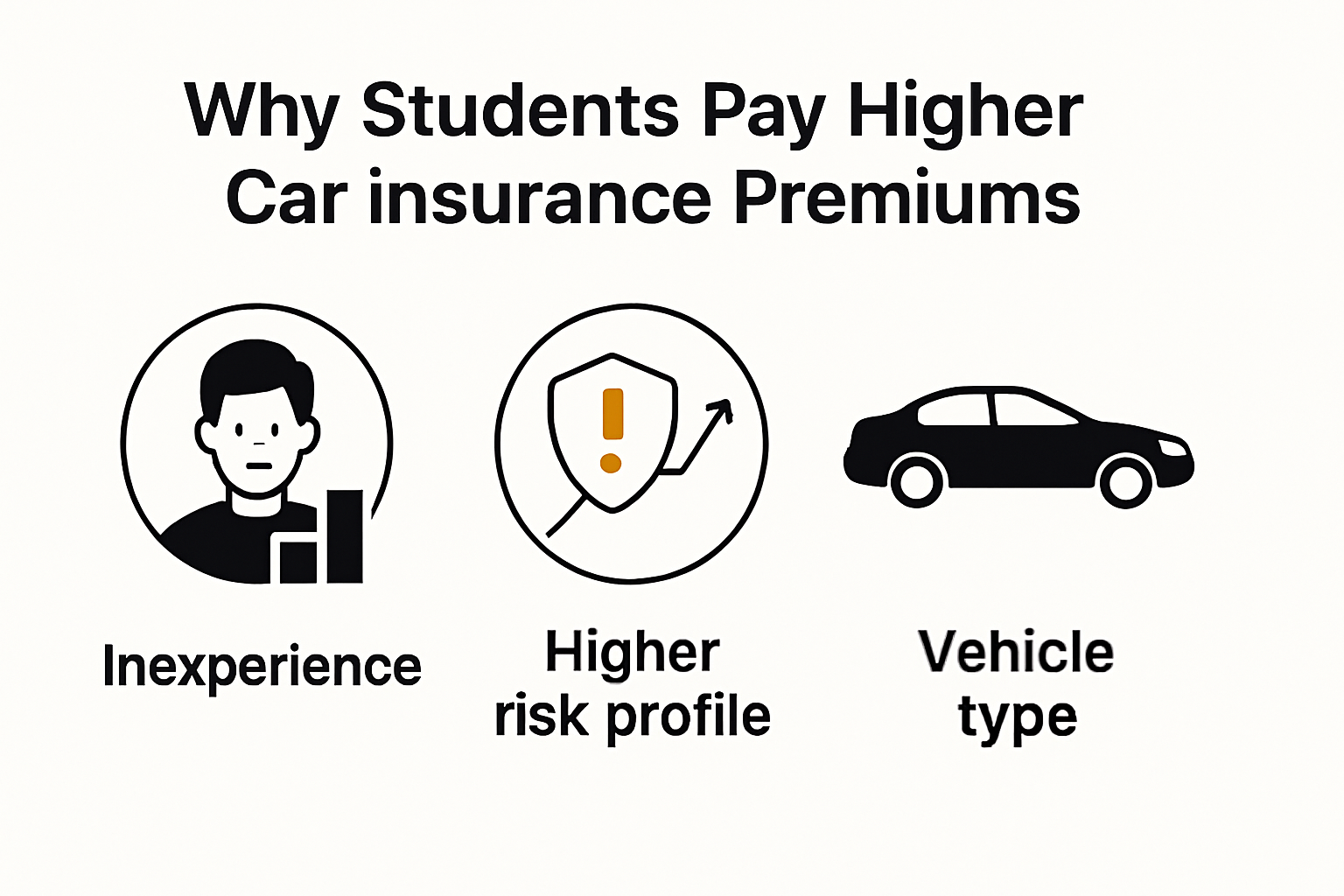
Car insurance can make student budgets groan. Here is the shocker though. Students under 25 often pay up to 40 percent more for insurance than older drivers. Most people think there is no way around it but clever students prove that a clean driving record and good marks can actually unlock big discounts most others miss.
Table of Contents
- Understanding Car Insurance For Students
- Key Factors Affecting Student Car Insurance Rates
- Money-Saving Tips And Student Discounts
- Choosing The Best Car Insurance Policy
Quick Summary
| Takeaway | Explanation |
|---|---|
| Young Drivers Face Higher Premiums | Students under 25 generally pay more for car insurance due to perceived higher risks associated with their inexperience and statistical likelihood of accidents. |
| Choose Coverage Wisely | Evaluate different insurance policy types, such as Third-Party, Third-Party Fire and Theft, and Comprehensive Coverage, to find the best fit for your financial capacity and vehicle needs. |
| Leverage Discounts | Take advantage of available discounts for good academic performance, completion of defensive driving courses, and maintaining a lower mileage, which can help reduce insurance costs significantly. |
| Assess Personal Risk Factors | Maintain a clean driving record and improve your credit score to show financial responsibility, which may lead to lower insurance premiums. |
| Conduct Comparative Shopping | Regularly compare quotes from various insurance providers to identify competitive rates and consider bundling policies for additional savings. |
Understanding Car Insurance for Students
Navigating car insurance as a student can be a complex and financially challenging journey. Young drivers typically face higher insurance premiums due to their limited driving experience and perceived higher risk on the road. Learn more about smart insurance strategies for students.
Why Students Pay More for Car Insurance
Statistically, drivers under 25 represent a higher risk category for insurance providers. According to research from the Automobile Association of South Africa, young drivers are more likely to be involved in accidents, which directly impacts their insurance rates. The data reveals several key reasons for elevated premiums:
- Inexperience: Limited driving history means less predictable road behavior
- Risk Profile: Higher likelihood of minor and major traffic incidents
- Vehicle Type: Students often drive older or less safety-equipped vehicles
Insurance companies calculate premiums based on complex risk assessment models. A young driver’s lack of extensive driving record translates to statistical uncertainty, compelling insurers to charge higher rates to mitigate potential financial losses.

Understanding Coverage Options
Students have multiple insurance coverage options tailored to their unique needs. The Road Accident Fund provides basic personal injury coverage, but comprehensive protection requires additional considerations. Key coverage types include:
- Third-Party Insurance: Minimum legal requirement covering damages to other vehicles and property
- Comprehensive Coverage: Protects against theft, damage, and third-party incidents
- Personal Accident Cover: Provides medical and disability protection for the driver
Making an informed choice involves understanding these options and assessing individual risk factors. Students should evaluate their specific circumstances, including vehicle value, driving frequency, and personal financial capacity.
By understanding the intricacies of car insurance, students can make strategic decisions that balance protection and affordability. Researching, comparing quotes, and exploring potential discounts can significantly reduce insurance expenses while maintaining essential coverage.
To help you compare the main insurance coverage types available to students, here’s a summary table of their features and benefits:
| Coverage Type | What’s Covered | Typical Cost | Best For |
|---|---|---|---|
| Third-Party Only | Damage to other vehicles/property | Lowest | Basic/required coverage on a budget |
| Third-Party Fire and Theft | Third-party plus theft and fire damage to your vehicle | Moderate | Extra protection without full coverage |
| Comprehensive Coverage | All third-party, theft, fire, & accidental damage to own | Highest | Maximum protection for newer vehicles |
| Personal Accident Cover | Medical/disability cover for you as the driver | Add-on/Varies | Additional personal medical protection |
Key Factors Affecting Student Car Insurance Rates
Navigating the complex world of car insurance requires students to understand the intricate factors that insurers consider when calculating premiums. Explore smart strategies for reducing your insurance costs and take control of your financial protection.
Personal Risk Profile
Insurance providers assess individual risk through multiple lenses. According to Financial News Agency, several personal characteristics significantly impact insurance rates:
- Academic Performance: Students with higher academic achievements often receive lower insurance premiums, as insurers correlate academic responsibility with responsible driving behavior
- Driving Record: Any previous traffic violations or accidents dramatically increase insurance costs
- Credit Score: Financial responsibility can indicate lower risk potential for insurers
Students with clean driving records and strong academic backgrounds demonstrate lower statistical risk, which translates into more favorable insurance rates.
Vehicle Characteristics
The specific attributes of a student’s vehicle play a crucial role in determining insurance premiums. Research from the Automobile Association highlights key vehicle-related factors:
- Vehicle Age: Older vehicles typically attract lower premiums due to reduced replacement costs
- Safety Features: Modern safety technologies can significantly reduce insurance expenses
- Vehicle Value: High-value or luxury vehicles naturally command higher insurance rates
Students can strategically choose vehicles that balance affordability, safety, and insurance cost-effectiveness. Opting for vehicles with robust safety features and moderate market value can result in substantial long-term savings.
Geographic and Usage Considerations
Location and intended vehicle usage represent critical factors in insurance premium calculations. Areas with higher crime rates, dense traffic, or increased accident frequencies typically result in elevated insurance costs. Students must consider:
- Parking Location: Secure parking areas can reduce theft and damage risks
- Annual Mileage: Lower annual kilometers driven often correlates with reduced insurance premiums
- Primary Use: Vehicles used exclusively for personal transportation may attract more favorable rates compared to those used for commercial purposes
By understanding these nuanced factors, students can make informed decisions that optimize their car insurance coverage while managing financial expenses effectively. Proactive research, comparing multiple insurance providers, and maintaining a responsible personal profile can significantly mitigate insurance costs.
To clarify how various factors influence student car insurance rates, here’s a table summarising the main considerations and their typical effects:
| Factor | How It Affects Premiums | Student Tip |
|---|---|---|
| Age | Under 25 pays higher premiums due to risk | Maintain good driving habits |
| Academic Performance | Good marks can reduce rates | Aim for high academic achievement |
| Driving Record | Violations/accidents increase cost | Keep a clean driving record |
| Vehicle Age | Older cars usually cost less to insure | Consider reliable older vehicles |
| Safety Features | More features lower premiums | Choose cars with modern safety tech |
| Parking Location | Secure parking means lower risk/cheaper insurance | Park in secure places |
| Annual Mileage | Less driving leads to lower rates | Limit unnecessary travel |
Money-Saving Tips and Student Discounts
Managing car insurance expenses can be challenging for students on a tight budget. Discover smart strategies to reduce your insurance costs and keep more money in your pocket.
Strategic Insurance Selection
Choosing the right insurance policy requires careful consideration and proactive research. According to Money Magazine South Africa, students can significantly reduce their insurance expenses by implementing targeted strategies:
- Comparative Shopping: Obtain quotes from multiple insurance providers to find the most competitive rates
- Annual Policy Review: Reassess your insurance needs annually to ensure you’re not overpaying
- Bundle Policies: Consider combining multiple insurance products for potential multi-policy discounts
Students should approach insurance as a strategic financial decision, carefully weighing coverage options against potential cost savings.

Vehicle and Safety Considerations
Research from AutoTrader South Africa highlights several ways students can reduce their insurance premiums through vehicle and safety choices:
- Security Enhancements: Install approved tracking devices, immobilizers, and alarm systems
- Parking Strategy: Use secure parking areas and provide proof of reduced theft risk
- Vehicle Selection: Choose vehicles with lower insurance risk profiles
Additionally, students can explore specific insurance features that offer financial relief. Telematics-based insurance programs that monitor driving behavior can provide significant discounts for safe and responsible drivers.
Academic and Personal Discounts
Many insurance providers offer unique discount opportunities for students who demonstrate responsibility and academic excellence:
- Good Student Discount: Maintain a high academic average to qualify for reduced premiums
- Defensive Driving Courses: Complete certified driving courses to demonstrate reduced risk
- Limited Mileage Policies: Choose policies that account for reduced driving during academic periods
Some insurers provide specific programs tailored to students, recognizing their unique financial constraints and lower risk potential when maintaining good academic and driving records.
By implementing these strategic approaches, students can effectively manage their car insurance expenses. Proactive research, responsible driving, and understanding available discounts are key to finding affordable and comprehensive coverage. Always communicate openly with insurance providers and explore all potential saving opportunities.
Choosing the Best Car Insurance Policy
Selecting the right car insurance policy requires careful consideration and strategic thinking. Understand the essentials of car insurance coverage to make an informed decision that protects both your vehicle and financial interests.
Understanding Policy Types
The South African insurance market offers multiple policy types designed to meet different student needs. According to the Financial Sector Conduct Authority, students should carefully evaluate three primary insurance categories:
- Third-Party Only: The most basic and affordable coverage, protecting against damages caused to other vehicles or property
- Third-Party Fire and Theft: Provides additional protection against vehicle theft and fire damage
- Comprehensive Coverage: Offers the most extensive protection, covering personal vehicle damage, theft, and third-party incidents
Each policy type presents unique advantages and limitations. Students must assess their individual risk profile, vehicle value, and financial constraints when making a selection.
Critical Policy Considerations
Insurance experts recommend students focus on several key factors beyond basic coverage:
- Excess Amount: Choose an excess that balances affordable monthly premiums with potential out-of-pocket expenses during claims
- Additional Benefits: Look for policies offering roadside assistance, emergency medical support, and rental car provisions
- Claim Process: Investigate the insurer’s reputation for efficient and transparent claims management
Technology has transformed insurance selection. Many providers now offer digital platforms allowing students to compare quotes, customize coverage, and manage policies through mobile applications.
Personalizing Your Insurance Strategy
Successful insurance selection goes beyond comparing prices. Students should consider:
- Vehicle Specific Requirements: Tailor coverage to your specific vehicle’s age, model, and value
- Personal Risk Management: Demonstrate responsible behavior through advanced driving courses and maintaining a clean driving record
- Regular Policy Reviews: Reassess insurance needs annually to ensure continued optimal coverage
By approaching car insurance as a dynamic financial tool rather than a static expense, students can develop a protective strategy that evolves with their changing circumstances. Comprehensive research, transparent communication with insurance providers, and a proactive approach to risk management are key to securing the most suitable car insurance policy.
Frequently Asked Questions
Why do students pay more for car insurance?
Students under 25 typically pay more for car insurance due to their inexperience and a higher statistical likelihood of being involved in accidents. Insurers often charge higher premiums to mitigate this risk.
What types of car insurance coverage are best for students?
Students should consider options like Third-Party Only for minimum legal requirements, or Comprehensive Coverage for maximum protection, depending on their financial capacity and vehicle needs.
How can students save money on car insurance?
Students can save money by maintaining good academic performance for discounts, completing defensive driving courses, and comparing quotes from various insurance providers to find competitive rates.
Are there discounts specifically for students?
Yes, many insurers offer discounts for students who demonstrate responsible behavior, such as above-average academic performance, completing defensive driving courses, or maintaining lower mileage on their vehicles.
Struggling With High Student Car Insurance Costs? There Is a Smarter Way
If you are tired of paying more simply because you are young or a student driver, you are not alone. Many South African students get frustrated with steep premiums, confusing policy choices, and feeling like they have to sacrifice cover just to save money. This article showed how important it is to compare coverage types, find student discounts, and keep a clean driving record but you still need a partner who makes it genuinely affordable and easy.
That is where King Price Insurance comes in. Protect yourself and your wallet with car insurance options built for students. Whether you want simple third party cover or the peace of mind that comes with comprehensive car insurance, our affordable solutions reward responsible drivers and offer special savings for careful students. Take control now and see how much you can save today. Visit King Price Insurance to get your quote in minutes and end the guessing game for good.
Recommended
- Top Insurance Tips for Students: Car, Home & Auto 2025 – Savvy Insurance
- Best Youth Driver Insurance Tips for 2025: Save and Stay Safe – Savvy Insurance
- Saving Money on Car Insurance: Top Tips for 2025 – Savvy Insurance
- Top Tips for Cheaper Car Insurance in South Africa 2025 – Savvy Insurance
- Moving and Storage Insurance Guide 2025: Protect Your Belongings – STOMO Mobile Storage and MOVEMO Moving Service
- What Insurance Do Couriers Need? A Comprehensive Guide – BHA Couriers



One Response